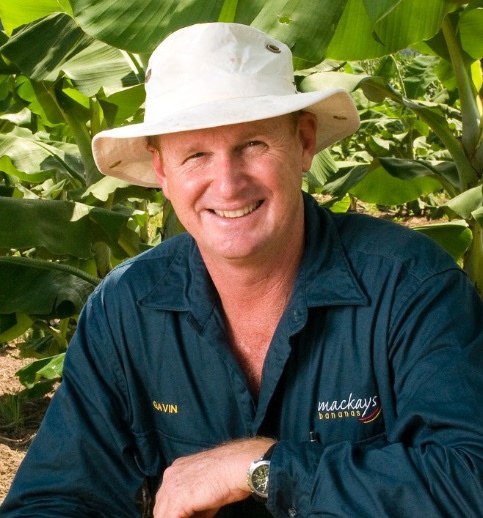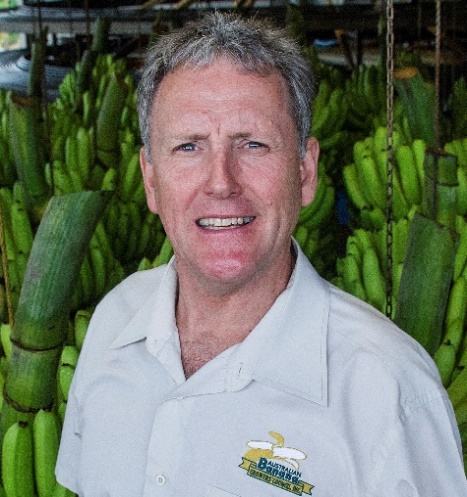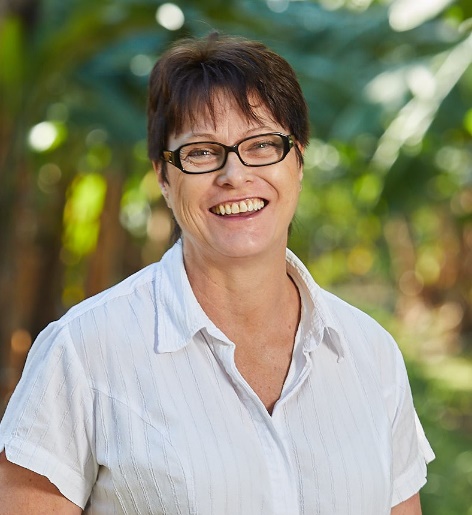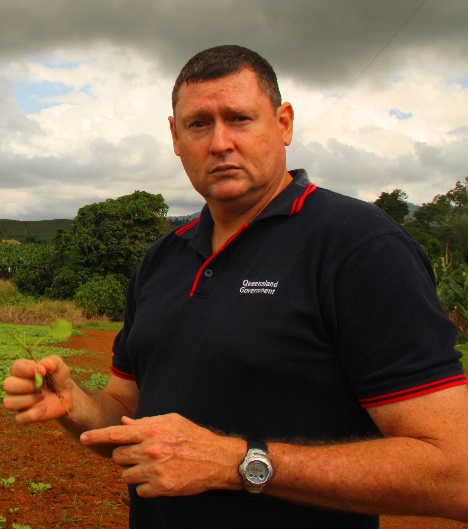Panama Tropical Race 4: Bending banana’s battle against Panama TR4
This episode is about how Queensland’s banana growers, the banana industry and the Queensland Government are managing the impacts of Panama disease tropical race 4, known as Panama TR4. Panama TR4 is a serious fungul disease of bananas and is one of the greatest threats to worldwide banana production.
Third-generation North Queensland banana grower Gavin Mackay recounts his experience after Panama TR4 was discovered on his Tully farm, Australian Banana Growers’ Council’s Chief Executive Officer Jim Pekin discusses the implications for the industry if the disease is left unchecked and how his organisation is supporting its members, Agri-Science Queensland’s Banana Production Systems team leader Stewart Lindsay talks about the research being done to control Panama TR4 and Biosecurity Queensland’s Panama TR4 program team leader Rhiannon Evans explains what is being done to stop the spread of Panama TR4.
Meet our guests
Program intro: Welcome to Turf and Surf, powered by Queensland’s Department of Agriculture and Fisheries, shaping and protecting food and fibre for tomorrow’s Queensland.
Host: As a tasty and healthy snack, a vital ingredient in smoothies, desserts, cakes and bread, a lolly, the star of a children’s television show and a northern New South Wales tourist attraction the humble banana enjoys a revered position in Australian society.
But the banana is under attack from an insidious fungus that threatens Queensland’s $580 million banana industry, an industry that provides jobs and income to regional communities.
Panama Tropical Race 4, or Panama TR4, is a serious disease of bananas. It’s caused by a fungus that lives in the soil and can be spread by the movement of infected planting material and contaminated soil and water.
Panama TR4 was first found in Far North Queensland in 2015 on a commercial banana farm in the Tully Valley. It can’t be eradicated and can survive in the soil for decades. In short,
Panama TR4 is one of the greatest threats to worldwide banana production. But here in Queensland, where over 95 percent of Australian bananas are grown, the disease has, so far, been successfully contained to just three farms.
I’m Brad Muir. In this episode of Turf and Surf, we’ll look at the effects of Panama TR4 on Queensland’s banana industry, what the Queensland Government is doing to help growers and the industry better manage the impacts of the disease and we’ll answer the question on everyone’s lips, are bananas safe to eat?
Program segue: You’re listening to Turf and Surf, the official podcast of Queensland’s Department of Agriculture and Fisheries. Shaping and protecting food and fibre for tomorrow’s Queensland.
Host: Gavin Mackay is a third generation banana grower from North Queensland. The Mackay family planted their first banana crop in 1945.
Today, the Mackay’s run farming properties covering 3600 hectares around Lakeland, Bundaberg and Tully growing a variety of crops including bananas.
In July 2017, Panama TR4 was detected on the farm Gavin runs with his cousin Steven.
Thanks for joining us Gavin. Discovering Panama TR4 on your farm must have come as quite a shock. What went through your mind when you realised what was going on?
Gavin Mackay: Yeah it was a bit of a shock to find it here but because Panama had been found in Australia previously in the Northern Territory and then two years before we got any infection on our farm, already started to work on our biosecurity plan and isolating our farm from the outside world as it was to try and keep any potential infection off our farms.
Host: Tell me a bit about the disease. How does the fungus affect banana plants?
Gavin Mackay: It is a fungus that actually like strangulates the plant and stops the flow of water inside the plant.
So effectively the plan boils and so it dies from the outside in. As that progression occurs it generates spores within the plant and the roots and from there that’s the way that the spores spread.
Host: How has Panama TR4 affected your business?
Gavin Mackay: Obviously it’s been a shock but I think it has some positives.
The biosecurity side of things, is probably something that farmers should embrace anyway. The best way to control this is early detection.
Host: Gavin, you mentioned that when TR4 was discovered on your farm, you’d already taken measures regarding TR4. What are those measures that you’ve taken to get on top of it?
Gavin Mackay: Yeah, just implementing practical things that limit the access to your farm so totally fencing the farm with pig proof fencing. Identifying zones within the farm.
There’s obviously a zone outside your farm when you haven’t got TR4 that’s the dirty zone, that’s the place where the infection is going to come from.
Your farm is a clean zone and the shed is like a transition zone and just really having one point of entry into your farm.
We actually adopted a coloured boot system, black gumboots on the farm and then white gumboots in the shed and then obviously your normal footwear or whatever outside the shed so on the, in the public area.
And just keeping those totally separate like no black boots come into the shed, you only use white boots in there.
You have like a sanitising dip everybody passes through before they come from the paddock to the shed and then before they leave the shed into the public area.
The only difference is that when you have the disease that swaps around. So before you tried to keep everything off your farm and then once you have the disease you have to keep everything on your farm.
Host: Well they seem to be simple and practical measures that anyone could put in place. In hindsight would you change anything in how you handle the situation when Panama TR4 was discovered on your property?
Gavin Mackay: Hindsight is a pretty good thing. I don’t think there is a lot we would have really done. Maybe, maybe started a bit earlier.
Like we actually started two years before we got any infection so I think there are enough positives out of what we did that yeah, starting earlier probably would have been better with the engagement of staff and all that sort of stuff as well.
So yeah, a little bit, not a lot actually but it has been a pretty good process.
Program segue: This Turf and Surf podcast is powered by Queensland’s Department of Agriculture and Fisheries. Shaping and protecting food and fibre for tomorrow’s Queensland.
Host: On this episode of Turf and Surf, we’re looking at the effects of the devastating fungus Panama TR4 on Queensland’s banana industry and what’s been done to help the industry manage the impacts of the fungus.
Since the initial detection in March 2015, the Queensland Government funded Panama TR4 program has worked closely with the Australian Banana Growers Council to control and contain the disease through surveillance, compliance on known infested properties and communication and education activities.
Jim Pekin is the Australian Banana Growers Council’s chief executive officer. Thanks for your time Jim. How has Panama TR4 affected the banana industry?
Jim Pekin: Yeah initially it was a shock but now, four and a half years later we can see the industry has adapted to this major biosecurity threat. But yeah it has changed the North Queensland industry forever.
Many growers have now done what they can to protect themselves by putting in place on-farm biosecurity. Indeed others around the industry have also changed practices.
Host: I’m wondering, what are the implications for the industry if the disease is left unchecked?
Jim Pekin: Well first, TR4 is a fungal disease which is carried by soil and water so mostly by people with boots, wheels and planting materials.
So those sort of factors have caused it to rapidly spread in recent years within and to many other countries so if we can contain that disease in Australia, great, but if, as you say, what’s the implications of not well it will spread and destroy the ability of plants and later farms to produce bananas.
Host: Well quite obviously no one wants that to happen. So let’s talk about what is being done to avoid that very situation. At an industry level Jim what has the ABGC been doing to support its members?
Jim Pekin: Probably three or four things. Since the outset in March 2015, we have been advising growers how to protect their farms from TR4.
For example, ABGC together with DAF extension people ran a very successful series of biosecurity workshops where growers use aerial photos of their own farms to consider what biosecurity measures they needed to put in place. So that’s one thing.
We got the support of growers nationally to buy the first infected farm and shut that down, that was 400 acres of bananas that was potentially going to spread the spores and this disease around the place. So we closed that operation down and still have and continue to maintain the security of that farm.
I suppose another one would be we continue to be involved in every aspect of TR4 be it the research and development as well as the biosecurity, you know the TR4 program.
And I guess comms, communications wise, we are involved in a range of channels to inform growers as to what is happening in the various aspects of TR4. Not just growers but the industry at large and the community surrounding that industry
Host: And, of course, the Queensland Government is doing its bit. In 2019 the ABGC and Biosecurity Queensland’s Panama TR4 program began developing a partnership agreement to jointly fund and deliver the program in Queensland until 2023. Jim, what outcomes has that partnership already delivered?
Jim Pekin: Well I think the main thing is we’ve been collaborating on the strategic level which is meant BQ delivering a successful program that is in line with what commercial bananas growers needed.
The proof of the major achievement is that in four and a half years there’s only been three farms that have come down with the disease.
Look, it’s really terrible news for those three farms, but on a bigger picture perspective that’s three farms in four and a half years being infected with TR4 is a credit to the TR4 program.
It’s also a credit to those infected farms because they’ve done what they can and all of the industry in terms of the biosecurity they put in place.
Host: Jim does that mean the industry can now breathe easy, that the worst of TR4 is over?
Jim Pekin: Unfortunately no, not at all. Based on the experience overseas and indeed in the Northern Territory with TR4.
There’s two risks you see, a flood event is one and there is almost no way of managing that risk for some growers. Secondly, people occasionally make mistakes in pleading with biosecurity.
So I guess the message still is all growers need a biosecurity plan and to keep non-essential people out of their farms, to wash down wheels and boots for those who enter, that sort of thing.
And if you are another member of the community, you please need to respect the need to stay out of banana farms unless you have got permission to enter them.
Program segue: You’re listening to Turf and Surf, the official podcast of Queensland’s Department of Agriculture and Fisheries. Shaping and protecting food and fibre, for tomorrow’s Queensland.
Host: On this episode of Turf and Surf, we’re looking at the effects of the devastating fungus Panama TR4 on Queensland’s banana industry and what’s being done to help the industry manage the impacts of the fungus.
Stuart Lindsay is the team leader for banana production systems with Agri-science Queensland. His team is leading research into controlling Panama TR4.
Thanks for joining us Stuart. Queensland began research into Panama TR4 in 2008, tell us about that research and what you’re trying to achieve?
Stewart Lindsay: We’re trying to sustain the banana industry in Queensland in the face of this disease and there’s a number of different ways we are doing that.
Supporting the industry and containing and stopping the spread as much as we can, the disease at the moment and at the same time we’re looking to develop longer term integrated cropping systems that are going to allow us to hopefully produce bananas in the future in the presence of the disease.
But that’s going to take time and so we need a two-prong approach and we need to know what we need to do now and we also need to prepare for an alternative scenario in the future.
Host: I guess the big question is, is there a silver bullet for Panama TR4?
Stewart Lindsay: I think experience tells us no.
Genetic resistance is a really, really key part of a future in the presence of this disease but right at the moment we don’t have the silver bullet genetics that everyone would like so we have to make do with what we have and build systems around that.
Host: So this is about managing the impacts of the fungus?
Stewart Lindsay: Absolutely. So in the first instance, our first and highest priority was really about research and development extension that supported the containment and quarantine effort that supported the banana industry and our sister agency Biosecurity Queensland in containing that disease.
So what do people need to know about what they needed to do right now to stop that from spreading further because at the end of the day the best scenario you can have is not to have this disease.
But you’re right, the future is a management future. It’s about a suppressive cropping system that manages the disease to a level where production is still economic.
Host: Panama TR4 has had a devastating effect on banana crops around the world. What are the prospects for developing a Panama TR4 resistant variety of banana?
Stewart Lindsay: Look I think they’re quite good.
We don’t currently have one that has all the attributes that both the producer wants, that the supply chain needs and that the consumer wants.
That’s probably the trick is you have to meet, you have to have a variety that ticks a lot of boxes for those three separate groups.
But we’re working towards that and so we’re certainly making strides in that area.
I think the reality is that the future looks different to the status quo and so as a result what we will do in the future will be different and people will just have to accept that it won’t be exactly the same and it will have different attributes and perhaps different varieties.
Host: When you say different attributes, does that include taste?
Stewart Lindsay: Absolutely. So it could be different varieties that are Cavendish, different varieties that aren’t Cavendish so you know Cavendish is the most dominant supermarket banana in Australia.
96 percent of all the bananas sold are of the Cavendish variety. That doesn’t mean there isn’t room for others but there’s some very good reasons why Cavendish has that dominance.
It has broad appeal and it’s easy to produce and handle in a mass-market sense. So if we can emulate some of those attributes, there’s nothing to say that we can’t bring other varieties with appeal to consumers. But I am also talking about the farming system.
The farming system I think will evolve to be a more integrated agro-ecological approach because, at the end of the day, that’s what is going to offer the solution to this disease I believe.
Program segue: You’re listening to Turf and Surf, the official podcast of Queensland’s Department of Agriculture and Fisheries. Shaping and protecting food and fibre for tomorrow’s Queensland.
Host: On this episode of Turf and Surf, we’re looking at the effects of the fungus Panama TR4 on Queensland’s banana industry and what is being done to help the industry manage the impacts of the fungus.
Rhiannon Evans leads Biosecurity Queensland’s Panama TR4 program which aims to control and contain the disease.
Thanks for joining us Rhiannon. What is Biosecurity Queensland doing to stop the spread of Panama TR4?
Rhiannon Evans: I am pleased to report that Biosecurity Queensland has had some real success in the containing the disease presence in Queensland to three farms in four and a half years.
So we are considering that this is quite a successful control and containment program. And we believe that a multipronged approach has led to the success.
First and foremost we have a surveillance program in place. And the surveillance is about early detection.
Once we’ve got early detection the trick is to employ strong compliance such as the destruction of the plant and placing biosecurity regulation upon the affected property.
We also recognise that it’s not just the infected property that can contribute to the spread of this disease. The entire community is responsible.
So we’ve got a strong education campaign that educates all stakeholders in what practices are the best practices for controlling and containing Panama.
The control and containment program has been particularly successful because of three key elements. We have a very strong consolidated industry who work in unison.
We have quite strong regulation in Australia and certainly in Queensland so we can use legislation to support the requirements of industry and government to protect our economic value.
We also have sufficient money in Australia to afford good research activities.
And I think without one of those three prongs that we would never have been as successful as we are today.
Host: Rhiannon, the Queensland experiences made us, somewhat reluctantly, something of a world leader in the management of Panama TR4 and recently we’ve had delegations from two banana producing countries visit Queensland to tap into our knowledge. Tell us a little bit about those visits?
Rhiannon Evans: We had one delegation from Columbia and then another delegation come from Ecuador.
They were very interested to see how Queensland had implemented control and containment activities and what the key aspects were for management in Queensland.
We took them to an infested property where they had an opportunity to have a look at the biosecurity controls that we have in place.
They had an opportunity to look at simple, straightforward solutions to complex problems and they have now provided us feedback that they’ll be looking to adopt some of those initiatives onto the properties in their countries.
Host: At a local level, what are the warning signs around Panama that growers should be on the lookout for?
Rhiannon Evans: This is a really good question. In terms of the most obvious, you’re looking for yellowing leaves and you’re certainly looking for a drop of the leaves as well to form a skirt around the pseudo-stem.
It’s very easy to mistake TR4, or Panama TR4, for other diseases. For yellowing leaves is, can be a symptom of many other things.
We do have a disease identification guide and we strongly encourage anybody who is doing field activities in banana farms to contact us for a disease identification guide and they can be available if you’d like to contact us at Panamatr4@daf.qld.gov.au.
Host: What precautions can growers take?
Rhiannon Evans: In terms of protecting their farm and protecting the rest of industry, critical at this point is do not share any planting material. Also employ really sound on-farm biosecurity practices.
Manage people and vehicle movement. Have processes such as when machinery or people are moving onto your property and off your property that they go through an effective decontamination process.
Host: Importantly, what should growers do if they find plants they suspect are infected with the disease?
Rhiannon Evans: Probably cannot emphasise enough here the importance to report early so that the plant can be managed and the surrounding plants can be managed in a manner which is going to protect the on-farm viability of the property.
Early detection means less disease can build up in the soil and this is better for the growers’ bottom line.
There is, in fact, a legal responsibility to report any suspect Panama disease symptoms in your plants and, if possible, to call Biosecurity Queensland on 13 25 23 in order to make that report.
Host: And what can members of the public do to prevent the spread of Panama?
Rhiannon Evans: Phoning ahead before actually attending a banana farm.
Talking to the property owner or occupier of the land to find out what conditions there might be for entry.
These are all things that will help maintain, like you say, a strong viable banana industry in this region.
And also, of course, taking the opportunity to report any suspect symptoms of plants that might be seen.
What I’d also reassure the community about is that bananas are still safe to eat.
We have demonstrated that the disease does not reach as far as the banana fruit and it certainly doesn’t affect the quality of the banana fruit that we eat.
Program outro: You’ve been listening to Turf and Surf. Turf and Surf is produced by the Queensland Department of Agriculture and Fisheries. For more information or to subscribe to this podcast, visit our website at daf.qld.gov.au.



